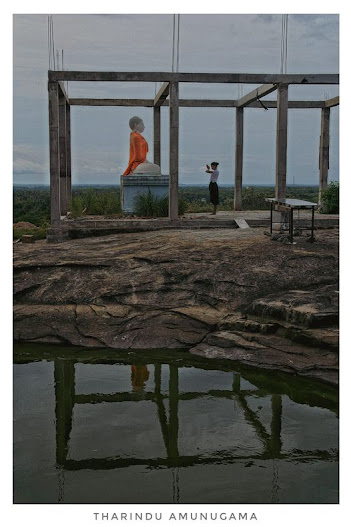 |
Buddhangala Raja Maha Viharaya, Padaviya |
Frames
are an important part of our lives. Indeed they are crucial elements of
the mind’s architecture. They simplify things, we believe. They offer
reference points. They abstract from the complex and offer something
that’s manageable when it comes to dealing with the complexity.
An
easy way to understand this is to look at a photograph. Another way is
to use your camera or phone to take a picture. Both the before and after
are instructive. Before we take a photograph we knowingly or
unknowingly ‘frame’ things. We can take a photograph of a cat, a tree, a
pebble, a crowd, a bridge or anything else, but we have to frame it.
Think
of a cat-photo. We can ‘place’ the cat anywhere within the frame and
that can make a difference. We could consider different angles which
would give us the cat in different shapes. The amount of light and the
shades of the cat and other objects within the frame would make for many
options.
Perhaps we are only interested in the cat, but
focusing on the creature will necessarily mean we leave other things
out. Maybe if we looked around we might find something else that’s more
compelling for capture. However, if we want the cat it’s the cat we will
get. On the other hand, one could reason that the cat would be there
later too, although ‘later’ might
offer a different set of options in
terms of light and shade, other elements within the frame, angle, etc.
The cat-fixation could mean that we missed forever the rarest butterfly
or the gaze of a girl from a window.
Now let’s consider ‘after.’
It’s framed. We focus on the visual and the text(s) therein. It’s all
abstracted from the rest of the universe (of our concerns). Just for a
moment, of course. Now we can see the cat, the play of light and shade,
the juxtapositions, intended or otherwise.
And we can let our
imagination wander. We can start with the ‘whatifs’ as certain critics
often do. That angle instead of this, perhaps at a different time in the
day, how about moving that saucer just a teeny bit nearer the cat, now
if only it was a black cat and not white, would have been better if the
cat was perched on a wall, stretching instead of crouched etc., etc. Why
a cat, one can ask. What’s outside the room (outside the frame,
essentially).
The mind wanders. In and out of frame. The hard
thing of course is to erase the frame altogether, to remove the (false)
distinction of ‘inside’ and ‘outside,’ to recognize frames as transient
entities, conveniences in fact, use them when you have to but always
being conscious that they are by and large arbitrary.
Take this
picture. It’s all about frames and reflections. Even the Buddha,
symbolized by statue, is framed when the doctrine speaks of the
subjectivity of frames. We ‘see’ the Buddha and miss the doctrine. Of
course it is not that ‘seeing’ the doctrine should necessarily involve
‘unseeing’ the Buddha. We can note frame or rather be conscious of it,
which, interestingly is not all that common a practice. The tendency is
to see things as being (necessary) fixtures of a given landscape.
We
see a child but cannot extrapolate to a wrinkled, bent-with-age, infirm
version of a few decades later. We see an old woman and the lines that
life has etched on her face stop us from seeing a young woman in love, a
worry-free little girl skipping around a flower garden.
We are trapped in frames of time and space. Nothing wrong in that. No prescription comes labeled ‘Imperative.’
We can reflect though. We can retire frames and perhaps that’s one way of retiring reflection too.
conditional truths
the back and forth of gaze
the dull reproduction
relativity of size
transience of capture —
and hands clasped in worship
seeking the eyes
that would frames dissolve.
Looking for the idyllic in dismal times
Water the gardens with the liquid magic of simple ideas, right now
There's canvas and brush to paint the portraits of love
We might as well arrest the house!
The 'village' in the 'city' has more heart than concrete
Vo, Italy: the village that stopped the Coronavirus
We need 'no-charge' humanity
The unaffordable, as defined by Nihal Fernando
Liyaashya keeps life alive, by living
The 'We' that 'I' forgot
'Duwapang Askey,' screamed a legend, almost 40 years ago
Dances with daughters
Reflections on shameless writing
Is the old house still standing?
Magic doesn't make its way into the classifieds
Small is beautiful and is a consolation
Distance is a product of the will
Akalanka Athukorala, at 13+ already a hurricane hunter
Did the mountain move, and if so why?
Ever been out of Colombo?
Anya Raux educated me about Juvenile Idiopathic Arthritis (JIA)
Wicky's Story You can always go to GOAT Mountain
Let's learn the art of embracing damage
Kandy Lake is lined with poetry
There's never a 'right moment' for love
A love note to an unknown address in Los Angeles
A dusk song for Rasika Jayakody
How about creating some history?
How far away are the faraway places?
There ARE good people!
Re-placing people in the story of schooldays
When we stop, we can begin to learn
Routine and pattern can checkmate poetry
Janani Amanda Umandi threw a b'day party for her father
Sriyani and her serendipity shop
Forget constellations and the names of oceans
Where's your 'One, Galle Face'?
Maps as wrapping paper, roads as ribbons
Yasaratne, the gentle giant of Divulgane
Katharagama and Athara Maga
Victories are made by assists
Lost and found between weaver and weave
The Dhammapada and word-intricacies
S.A. Dissanayake taught children to walk in the clouds
White is a color we forget too often
The most beautiful road is yet to meet a cartographer

0 comments:
Post a Comment